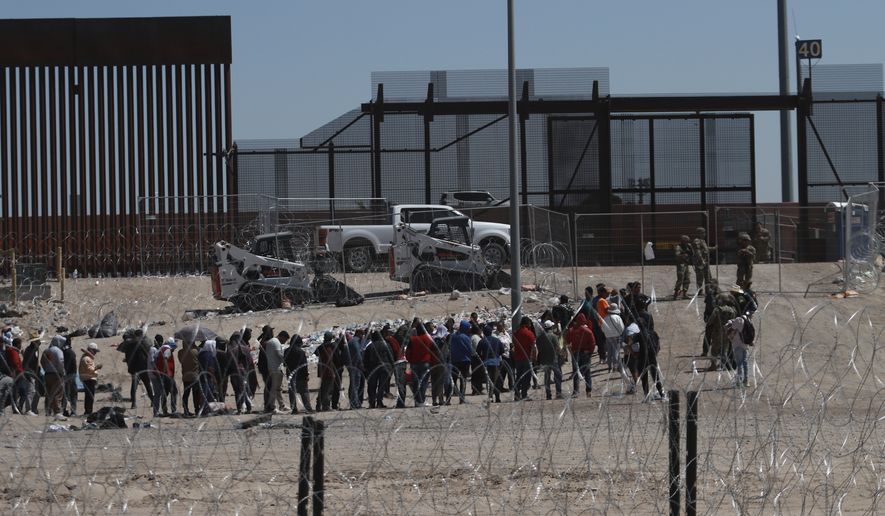The Border Patrol would beef up its staff and bus out migrants ahead of dignitary visits to hide the true extent of the chaos at the southern border, leaving the false impression that they were prepared to handle a surge, according to an inspector general’s report.
One agent told investigators that the Border Patrol would “make this place look fit and proper” every time a visitor was expected. After the visit, agents would “go right back to overfilled pods and lack of staff and equipment to handle the situation.”
That meant the visitors, some of them likely members of Congress, were “not shown how conditions are in reality,” the inspector general said.
The reality was that agents were overwhelmed, overworked and frustrated with the chaos, the inspector general said. The audit report says Customs and Border Protection and Immigration and Customs Enforcement, the two main immigration enforcement agencies, are stretched to their breaking points.
The agencies kept staffing the same even as their duties and workloads soared, the audit found.
Nearly 90% of law enforcement employees surveyed in each agency said they lack enough staff to handle another migrant surge.
SEE ALSO: Gov. Greg Abbott announces ‘border force’ to defend Texas border against migrant surge
The audit was released as the Department of Homeland Security prepared for a surge with the looming end of Title 42, the policy that allowed agents to expel immigrants who entered the country illegally. Title 42 expires Thursday.
CBP employees complained of operating with a “skeleton crew,” able to do little more than process new arrivals. Duties include restocking shelves with snacks for the migrants, delivering meals and keeping watch on migrants treated at hospitals.
One agent said it “feels more like social worker duties rather than law enforcement.”
Morale is so low that the agencies face a wave of retirements and resignations, leaving them in an even worse position to handle conditions at the border, the audit concluded.
Agent suicides are also rising at the Border Patrol, said the inspector general, citing congressional testimony from the agents’ labor union.
“CBP’s and ICE’s current management of law enforcement staffing resources is unsustainable,” the inspector general said. “CBP and ICE workloads have grown significantly due to factors beyond DHS’ control, such as increasing border encounters and travel volume. Despite greater workloads, staffing levels have remained the same, with CBP and ICE using details and overtime to temporarily fill staffing gaps along the Southwest border.”
SEE ALSO: DHS lets journalists watch deportation flight as part of border PR campaign
Investigators said it’s already happening.
Border Patrol agents said they are seeing an increasing number of “gotaways” — migrants known to have avoided detection because agents are stuck processing people back at stations and can’t be out on the line detecting and interdicting crossers.
Agents saw a 303% increase in gotaways from 2019 through most of 2022.
“One of our duties is the detention and processing of non-citizen migrants, which is what almost all of our manpower is being delegated to do,” one Border Patrol agent told investigators. “This does prevent us from doing the other part of the duties/responsibilities we were hired for, which is deterring or apprehending individuals that have made an illegal entry into the United States.”
At ICE, which handles detention, deportation and arrests in the interior of the U.S., officers said the surge of people means they are no longer tracking down and arresting criminals and are instead doing paperwork.
ICE’s deportation force made 92,108 arrests of migrants with criminal convictions in fiscal 2019 during a border surge under President Trump. By contrast, ICE’s deportation force logged just 18,173 criminal arrests in the first seven months of fiscal 2022.
In 2019, ICE deported 267,258 illegal immigrants. Over the first seven months of 2022, that fell to 35,260.
“Deportation officers we spoke to on the Southwest border and those detailed from other ICE offices told us that morale is affected because deportation officers are spending more time processing paperwork that could have been done remotely and releasing migrants instead of enforcing immigration law,” the inspector general said.
Meanwhile, Homeland Security Investigations, the division that is supposed to track down smugglers and child predators, has been reduced to “providing security at processing facilities,” said the inspector general, citing one HSI agent’s sense of the situation.
Homeland Security objected to the report. It said the methodology of the inspector general’s survey wasn’t up to standard and the results were “misleading.”
Jim Crumpacker, the department’s liaison to the inspector general, pointed to mental health support in the form of a chaplaincy service and a suicide prevention specialist to plan ways to reduce a rising suicide rate in CBP. ICE also released a series of videos and posters designed to raise awareness of suicide.
Mr. Crumpacker said the inspector general ignored steps the department has taken to lessen the burden on agents and officers. Those include hiring “processing coordinators” to do some caretaking duties and paying contractors to provide security or supply provisions.
• Stephen Dinan can be reached at sdinan@washingtontimes.com.




Please read our comment policy before commenting.